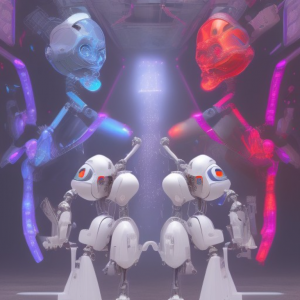
AI chatbots have become increasingly prevalent in today’s digital landscape, transforming how businesses and individuals interact and engage with technology. These generative AI chatbots utilize artificial intelligence algorithms to mimic human speech and conversations, providing instant responses and assistance to users. They are employed in various industries, such as customer support, virtual assistance, and information retrieval, enhancing efficiency and improving user experiences.
OpenAI’s ChatGPT has captivated millions of users. As an AI chatbot, it has proven useful in generating content ideas, assisting with writing emails, and solving complex problems. However, while ChatGPT has its merits, it is essential to acknowledge its limitations, such as outdated training data. This is where Google’s Bard, the tech giant’s latest response to ChatGPT, aims to shine by providing real-time and current information.
This article delves into the main differences between ChatGPT and Google Bard, examining their training models, data sources, capabilities, user experiences, and potential future integration.
ChatGPT vs Google Bard: A Comparative Analysis
At the core, both ChatGPT and Google Bard employ natural language processing to generate a human like response based on the user prompt or query. Both these chatbots have gained attention for their impressive conversational abilities and have been deployed in a variety of real-world scenarios. However, the key distinction lies in their data sources and models.
The underlying technology of ChatGPT is the Generative Pre-training Transformer 3 (GPT-3) or Generative Pre-training Transformer 4 (GPT-4) model, depending on the version. It draws from a vast dataset comprising Common Crawl, Wikipedia, books, articles, and open internet sources. Nonetheless, its training data ends in 2021, restricting its knowledge of current events and research.
On the other hand, Google Bard relies on Google’s Language Model for Dialogue Applications (LaMDA). Its training data, known as Infiniset, includes Common Crawl, Wikipedia, documents, conversations, and dialogues from the web. Moreover, Bard has the ability to search the internet in real-time, allowing it to provide up-to-date answers and the latest research findings.
ChatGPT is available for free to all users, but it also has a subscription-based service called ChatGPT Plus. Subscribing to ChatGPT Plus provides users extra perks such as peak-time access, quicker response times, priority feature access, and the ability to utilize GPT-4. On the other hand, Bard is currently accessible to users without any charges.
Google Bard vs ChatGPT: Comparing Language Models
Both Google Bard and ChatGPT rely on transformer architecture, a neural network model that processes sequential input. The difference lies in their training data and specific design objectives.
ChatGPT, as part of OpenAI’s GPT series, has been trained on a diverse dataset from the internet, enabling it to understand and generate a wide range of text for various purposes. In contrast, LaMDA, the language model used by Google Bard, was purposefully designed for more natural and open-ended conversations with humans. It excels at understanding the intent behind user questions and context nuances. To achieve this, Google employed a hierarchical clustering approach, grouping high-level concepts and topics to inform the model’s responses.
ChatGPT, with its statistical pattern-based text generation, functions not only as a chatbot but also as a summarizer, translator, and more. On the other hand, LaMDA focuses on dialogue and conversation, making it more adept at conversing like a human but potentially less effective at summarizing lengthy texts.
Google Bard vs ChatGPT: Utilizing AI Capabilities
ChatGPT shines in tasks such as generating large amounts of text, aiding in writing articles and emails, and providing content marketing ideas. Its extensive training in web text makes it a go-to tool for various natural language tasks, powering AI tools like Jasper, Copy.ai, and Bing’s AI tools.
In contrast, Bard’s AI language model allows it to draw information from the web in real-time. This positions Bard as a valuable resource for answering questions across diverse topics. It can provide up-to-date information, making it particularly useful for current events, research, and specific inquiries. Users can ask Bard questions about recipes, party planning tips, historical events, and more, benefiting from its ability to synthesize information from the internet.
While ChatGPT can generate text in large quantities, the real-time data access of the Bard AI model allows it to offer more accurate and updated information. For example, Bard can summarize recently published books and provide insights into their public and critical reception. ChatGPT, on the other hand, may struggle with such specific and time-sensitive queries.
Google Bard vs ChatGPT: User Experience and Integration
When it comes to user experience, Bard has the upper hand with its sleek and user-friendly interface. The formatted text is easier to read and navigate than ChatGPT’s chunky format. Additionally, Bard offers the convenience of editing questions after they have been asked and presents multiple prepared responses. Each response is accompanied by a “Google it” call-to-action, encouraging users to validate the sources.
The Google team has hinted at integrating Bard into its search engine, envisioning a simplified way for users to access information across complex topics. Bard’s ability to transform complex concepts into easily digestible formats can provide valuable insights into varying perspectives, particularly in areas where definitive answers may not exist.
On the other hand, Microsoft has already integrated aspects of OpenAI’s GPT-4 model into its Bing search engine, offering users a ChatGPT-like experience within the search bar, albeit with limitations and a waiting list for full access.
Google Bard and ChatGPT Head to Head
Both ChatGPT and Bard offer unique strengths and cater to different needs. Their key differences lie in their underlying architectures and the specific functionalities they provide.
ChatGPT excels at generating and summarizing text, making it valuable for creative writing, content creation, and more generalized tasks.
Google Bard, powered by LaMDA, focuses on real-time information retrieval, making it a reliable source for up-to-date research, current events, and specific inquiries. As these AI chatbots continue to evolve and integrate into various platforms, it will be fascinating to witness how they shape how we access and interact with information.
Future Developments and Potential
Looking ahead, both ChatGPT and Bard have exciting potential for further development. OpenAI’s GPT-4, which ChatGPT is built upon, holds promise for even more advanced natural language processing capabilities. With improvements in training data and model architecture, future iterations of ChatGPT may overcome some of its current limitations, providing users with enhanced text generation and summarization capabilities.
On the other hand, Google Bard’s integration into Google Search has the potential to revolutionize how people access and understand information. Bard aims to enhance research, education, and various industries by simplifying complex topics and presenting diverse perspectives. The integration of LaMDA into Google’s search engine could transform the way users interact with Google search results, gaining deeper insights and understanding across a wide range of subjects.
Ethical Considerations and Responsible AI Use
As AI chatbots like ChatGPT and Google Bard become more prevalent, it is crucial to address ethical considerations and promote responsible AI use. These chatbots rely on vast amounts of training data, which can sometimes contain biases and perpetuate misinformation. Developers and researchers need to ensure that ongoing efforts are made to mitigate these biases and improve the reliability and fairness of the AI models.
Additionally, transparency and clear communication about the capabilities and limitations of AI chatbots are essential. Users should be aware when they are interacting with an AI system and understand the boundaries of its knowledge and abilities. OpenAI’s approach with ChatGPT, openly acknowledging its limitations as a bot, sets a precedent for transparency in AI communication.
Furthermore, as AI chatbots become more sophisticated and indistinguishable from human conversation, it is crucial to establish guidelines and safeguards to prevent the malicious use of such technology. Robust ethical frameworks and regulations should be in place to protect individuals’ privacy, prevent the spread of misinformation, and ensure the responsible and accountable deployment of AI systems.
The Human-AI Collaboration
While AI chatbots like ChatGPT and Google Bard demonstrate impressive capabilities, it is vital to recognize the value of human expertise and involvement. These chatbots should be seen as tools that augment human intelligence rather than replace it. Human judgment, critical thinking, and creativity are invaluable in various domains, and AI chatbots can serve as powerful aids in assisting and enhancing human decision-making processes.
The advent of AI chatbots like ChatGPT and Google Bard has ushered in a new era of human-machine interaction. Each chatbot brings unique strengths to the table, with ChatGPT excelling in text generation and Bard providing real-time access to information.
As these technologies continue to advance, it is essential to foster responsible AI use, address ethical considerations, and recognize the collaborative potential between humans and AI. By leveraging the strengths of both humans and AI, we can harness the full potential of these chatbots to empower and augment our capabilities in various aspects of work, research, and daily life.




